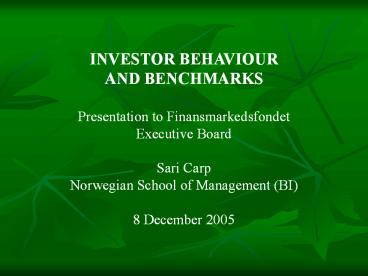INVESTOR BEHAVIOUR PowerPoint PPT Presentation
1 / 18
Title: INVESTOR BEHAVIOUR
1
INVESTOR BEHAVIOUR AND BENCHMARKS Presentation
to Finansmarkedsfondet Executive Board Sari
Carp Norwegian School of Management (BI) 8
December 2005
2
PART I Background on Behavioural Finance
3
Isaac Newton (losing investor in the South Sea
Bubble) I can calculate the motions of the
heavenly bodies, but not the madness of people.
4
- Three Viewpoints on Market Efficiency
- (borrowed from Richard Thaler)
- Efficient Market Zealot (vanishing breed)
- Security prices are always equal to intrinsic
value. - Price movements are random, and hence
unpredictable. - Behavioural Finance Zealot (figment of EMZs
imaginations) - Prices depend only on market psychology.
- It is easy to predict price movements.
- Sensible Middle Ground (nearly everyone)
- Prices are highly correlated with intrinsic
value, but sometimes diverge significantly. - It is sometimes possible to predict prices, but
generally not with great precision.
5
The Development of Behavioural Finance Research
- Documentation of anomalies
- Theory building Economics Psychology
- Testing of theories
- Experimental
- Empirical
6
Bounded Rationality
? Decision Making Rules Heuristics
? Biases
? Market Imperfections Anomalies
7
PART II Investor Behaviour and Benchmarks
8
Psychology of Benchmarking
- Fundamental human desire to evaluate ones own
abilities - Cannot assess abilities directly, so evaluate the
result of abilities i.e., performance - Even if performance can be measured unambiguously
(e.g. time to run a race), how do we know if its
good? - compare with others times
- If an objective, non-social criterion exists,
then evaluation relative to others is not used - Focus on a reference point, or goal, decreases as
the difference between it and ones own ability
increases
9
Antecedents
- Prospect Theory (Kahneman and Tversky, 1979)
- ascribes value to gains and losses, not total
wealth - decision makers are risk averse in gains, risk
seeking in losses - pain of loss is sharper than pleasure of gain
- March and Shapira, 1992
- two reference points aspiration and survival
- decision makers tolerate high risk when resources
are below reference point, lower risk when
resources are above reference point - decision makers focus only on one of two
reference points at a time
10
Model of Investor Risk Behaviour
- Performance (return) evaluated relative to two
benchmarks - Success (S)
- Exit (X)
- In each period, investors choose portfolio risk
according to - benchmark(s) focused on
- distance from focal benchmark(s)
11
Timeline
time 2 portfolio values change again Success and
Exit benchmark returns also change investors
restrategize based on new values
time 0 portfolios homog. in value,
variance heterog. in assets
time 1 portfolio values change according to
random walk investors choose risk strategies
based on own returns relative to Success and Exit
levels
time t evaluation period ends investors
performing below Exit are eliminated from the
market all others may invest again
12
Risk Taken Relative to Performance Benchmarks
Success Focus Exit Focus Mixed Focus
Risk
X
S
Performance (Cumulative Return)
13
Risk Taken Relative to Performance Benchmarks
Risk
X
S
Performance (Cumulative Return)
14
Mutual Fund Manager Data
- Offshore
- 787 funds (Datastream)
- 25 countries
- all equity
- 1993-2002
- U.S.
- 7,606 funds (CRSP)
- equity and bond
- 2001-2002
- actively managed (no index funds)
- single country focus
15
Results from Fund Manager Data
- Results support model highly statistically
significant - Model holds across economic, political and legal
contexts - Buthow can we know if benchmarking is driven by
behavioural or compensation based factors?? - By comparing individual and institutional
investors, we can factor out the compensation
based element
16
VPS Data
- Unique in the world
- Gold mine for behavioural research!!!
- Some behavioural research has been done on
similar databases from other Scandinavian
countriesbut, these databases are incomplete - Very famous behavioural research has been done on
an individual investor database from a U.S.
brokerage firmbut, this database is both
incomplete and biased
17
VPS Data
- Complete database of ownership in Norwegian stock
market - 10 years of monthly portfolios for each investor
- Investors categorized as individual, financial
institution, non-financial corporation,
government or foreign investor - Tracks each investor by ID over time, allowing
comparisons of investment decisions under same
conditions - Eliminates sample bias
18
Predicted Results on VPS Data
- Both professionals and individuals will take
increased risk as their performance improves
above the Success or Exit points this result
will be more pronounced for professionals - Both groups will take increased risk as
performance deteriorated below Success or Exit
points this result will also be more pronounced
for professionals - So, the pattern will be the same, but more
extreme for professionals

